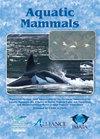Distribution and Abundance of California (Zalophus californianus) and Steller (Eumetopias jubatus) Sea Lions in the Inshore Waters of Washington, 2013-2016
IF 0.8
4区 生物学
Q4 MARINE & FRESHWATER BIOLOGY
引用次数: 0
Abstract
Two species of sea lions occur in the in387land waters of Washington State: the California sea lion (Zalophus californianus) and the Steller sea lion (Eumetopias jubatus). Both species breed elsewhere, but they typically move into Puget Sound and adjacent waters of the Salish Sea from autumn through spring. There is a need for information on their current abundance and seasonal use patterns as both species prey heavily on threatened/endangered stocks of salmon and steelhead trout (Oncorhynchus spp.), and empirical abundance estimates of these species are lacking for inland Washington waters. From 2013 to 2016, we conducted 39,399 km of aerial surveys for marine mammals in this area, sighting 255 groups of sea lions. We used a subset of 7,841 km of effort and 165 sea lion sightings made during surveys in good sighting conditions to estimate in-water abundance using line-transect methods. Historical tagging data collected in Pacific Northwest waters were used to evaluate the proportions of time that each species spent on land and conducting dives, and then to develop correction factors to derive total abundance for both sea lion species, providing the first empirical abundance estimates for these waters. We estimated that between 33 and 442 California sea lions were found in Puget Sound/Hood Canal in different seasons, with nearly 3,000 being found in the broader inland Washington waters in the peak season (spring). Steller sea lions occurred in much smaller numbers, with a peak of 219 animals in Puget Sound/Hood Canal/Strait of Juan de Fuca in autumn (and possibly as many as 600 to 700 in the entire study area). While some estimates suffer from low precision, this study demonstrates that substantial numbers of sea lions use waters of the study area throughout much of the year. Our results provide an important step toward a better understanding of these two species in the inland waters of Washington, as well as their potential effects on protected salmonid prey species.2013-2016年华盛顿近海加利福尼亚海狮(Zalophus californians)和斯特勒海狮(Eumetoas jubatus)的分布和丰度
在华盛顿州的387陆地水域有两种海狮:加利福尼亚海狮(Zalophus californianus)和斯特勒海狮(Eumetopias jubatus)。这两个物种都在其他地方繁殖,但它们通常从秋天到春天都搬到普吉特海湾和邻近的萨利希海水域。有必要了解它们目前的丰度和季节性使用模式,因为这两个物种都大量捕食受威胁/濒危的鲑鱼和钢头鳟鱼(Oncorhynchus spp.),并且缺乏这些物种在华盛顿内陆水域的经验丰度估计。从2013年到2016年,我们对该地区的海洋哺乳动物进行了39399公里的空中调查,发现了255组海狮。我们使用了7841公里的一个子集和在良好的观测条件下进行的165次海狮观测,使用样线法估计水中丰度。在太平洋西北水域收集的历史标记数据用于评估每个物种在陆地上花费的时间和进行潜水的时间比例,然后开发校正因子来获得两种海狮的总丰度,为这些水域提供了第一个经验丰度估计。我们估计,在不同的季节,在普吉特海湾/胡德运河发现了33到442只加利福尼亚海狮,在旺季(春季),在华盛顿更广阔的内陆水域发现了近3000只。虎头海狮的数量要少得多,秋天在普吉特海湾/胡德运河/胡安德富卡海峡的峰值为219只(整个研究区域可能多达600到700只)。虽然有些估计精度不高,但这项研究表明,大量的海狮在一年中的大部分时间里都在研究区域的水域活动。我们的研究结果为更好地了解华盛顿内陆水域的这两个物种以及它们对受保护的鲑鱼猎物物种的潜在影响提供了重要的一步。
本文章由计算机程序翻译,如有差异,请以英文原文为准。
求助全文
约1分钟内获得全文
求助全文
来源期刊

Aquatic Mammals
MARINE & FRESHWATER BIOLOGY-ZOOLOGY
CiteScore
1.60
自引率
16.70%
发文量
99
审稿时长
>12 weeks
期刊介绍:
Aquatic Mammals is a peer-reviewed journal sponsored by the European Association for Aquatic Mammals (EAAM), the Alliance of Marine Mammal Parks and Aquariums (AMMPA), and the International Marine Animal Trainers’ Association (IMATA). Aquatic Mammals publishes articles related to marine mammals (whales, dolphins, seals, fur seals, sea lions, walrus, dugongs, manatees, sea otters, and polar bears). Topics of publication on both captive animals and wild marine mammals include aspects of husbandry; behavior; conservation; veterinary medicine; anatomy; physiology; training; population trends; and the effects of pollution, climate change, and noise.
 求助内容:
求助内容: 应助结果提醒方式:
应助结果提醒方式:


